If your dental practice isn’t showing up in AI-generated answers, you’re already out of the running.
Patients aren’t just Googling anymore.
They’re asking ChatGPT who the best Invisalign provider near them is.
They’re using Perplexity to compare dentists in their zip code.
They’re talking to Siri and Gemini like digital assistants, not search engines.
And they’re booking appointments with the practices that show up, by name, in those answers.
This isn’t about keywords. It’s not about backlinks, branding, or even local map packs anymore.
This is about getting picked by the AI tools your patients trust.
That’s where GEO (Generative Engine Optimization) comes in.
It’s the fastest-growing and most overlooked edge in dental marketing. It’s how forward-thinking practices are getting cited, recommended, and booked, without relying on ads or outdated SEO tactics.
If your content doesn’t show experience, clarity, and trust? The AI skips it.
GEO for dentists is the blueprint to fix that, so when someone asks an AI tool for the best dentist in your city…
Your name is the one that shows up.
Table of Contents
What the Heck Is GEO (and Why Should Dentists Care?)
Let’s clear something up right out of the gate: GEO doesn’t stand for “geolocation” anymore.
In 2025 Q4, GEO means Generative Engine Optimization and it’s the most important shift in digital marketing for dentists since the rise of mobile search.
GEO is the art and science of getting your dental practice featured in answers generated by AI tools like ChatGPT, Perplexity, and Google Gemini.
These generative engines don’t serve up a list of 10 blue links like Google used to. They synthesize responses based on content that’s accurate, human-sounding, and written in a way that LLMs (large language models) understand and trust.
And here’s why that matters: Your patients are already using these tools to find dentists.
They’re typing things like:
- “What’s the best dental practice near me that takes Delta Dental?”
- “Which cosmetic dentist in Atlanta has the best reviews?”
- “Is Invisalign better than braces, and who offers it locally?”
These tools are answering with recommendations, not just search results. That means if your practice’s content isn’t written for AI… you don’t get mentioned at all.
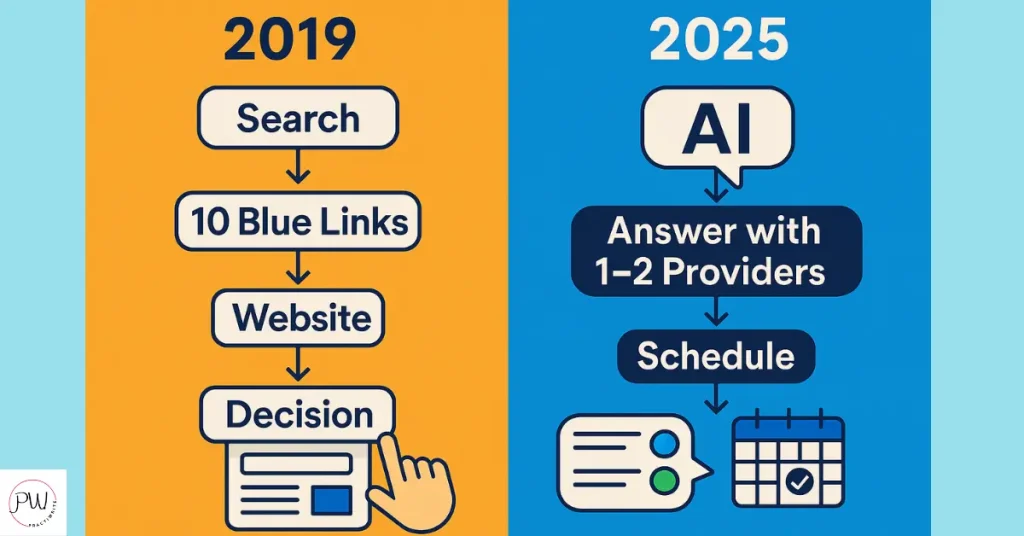
GEO = Showing Up Where Patients Are Searching Now
This isn’t some future trend. It’s already here.
- According to Statista, as of Q3 2025, 41% of adults in the U.S. now prefer to use AI tools like ChatGPT and Perplexity instead of Google to get answers and recommendations.
- A Semrush study from August 2025 shows a 66% increase in branded and local business queries inside generative engines since January.
- Per Ahrefs, content that ranks in generative engines typically shares a few traits: it’s clear, human-sounding, experience-backed, and citation-friendly.
So if your website, service pages, and blog posts aren’t structured for these engines? You’re invisible to nearly half the patients who are actively searching for a provider like you.
GEO Is How You Get Picked in the Age of AI
This isn’t just a new SEO tactic. It’s a full-blown shift in how trust and authority are earned online.
Generative Engine Optimization helps your practice:
- Show up in AI answers and recommendations
- Build authority through human-first, expert-backed content
- Convert high-intent patients already asking about your services
- Future-proof your online visibility as Google continues integrating generative AI into its core search results
Dentists who ignore this are falling behind.
Dentists who embrace GEO are getting found and getting booked.
GEO vs. SEO: What Actually Gets You Featured in AI Search (and Why It Matters to Dentists)
If you’re still marketing your dental practice like it’s 2019, you’re invisible in 2025.
Search has changed completely.
Patients aren’t just Googling “dentist near me” anymore. They’re asking AI tools like ChatGPT, Perplexity, and Gemini for recommendations, comparisons, and even direct answers about local dentists.
And here’s what most dentists don’t realize: your website content is now being pulled into these AI responses, but only if it’s written and structured in a way these engines can understand, trust, and prioritize.
That’s what GEO is all about.
Wait, So How Is GEO Different from SEO?
Let’s break it down:
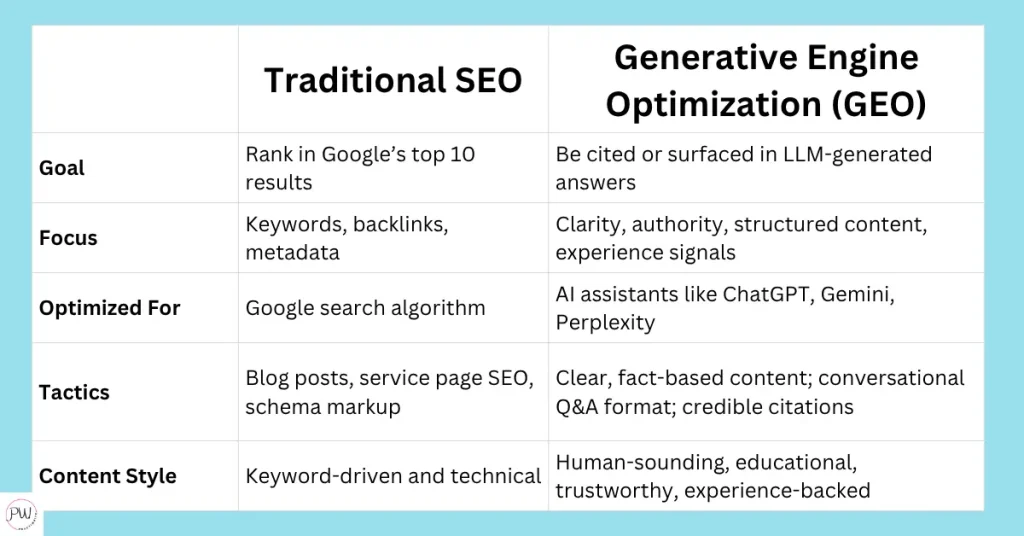
Here’s why that matters: LLMs don’t just crawl the web. They synthesize it. They pull in high-quality, clearly written, frequently updated content with signals of trust and authority.
That means the dentists who invest in GEO now are the ones who will be featured first when someone types into ChatGPT:
- “Who’s the best cosmetic dentist in San Diego?”
- “Which dentist near me has the best Invisalign reviews?”
- “What’s the cost of veneers in Miami, and who offers them?”
Patients Are Asking AI Tools Specific, Local Questions
LLMs are now the first stop for patients searching for:
- “Best pediatric dentist in Austin with weekend hours”
- “Affordable veneers in Charlotte – what’s the average cost?”
- “Top-reviewed emergency dentists open now near me”
This shift isn’t speculative. It’s measurable.
According to Semrush’s 2025 AI Overviews Study, searches that begin with question-based queries (“who,” “what,” “best,” “near me”) have grown 62% in generative engines like Perplexity and ChatGPT since January 2025.
The most common categories? Healthcare, home services, and local businesses like dental practices.
These aren’t broad information searches. They’re decision-stage prompts. And the businesses showing up in AI-generated answers are the ones who’ve done the work to be found.
SEO Isn’t Dead. It’s Just Not the Whole Picture Anymore.
We’re not throwing SEO out the window. Traditional SEO still matters, especially for visibility on Google and for long-term content discovery. But it’s not enough.
You now need to optimize for how AI reads, understands, and recommends content.
That means:
- Clear, direct language (not marketing fluff)
- Answering real patient questions in plain English
- Citing credible sources
- Writing in a natural, human tone
- Structuring content in ways that AI can segment, summarize, and trust
This is how you show up when someone asks ChatGPT “Which dentist in Nashville accepts emergencies and has great reviews?” and it answers with:
“Dr. Sarah Thompson at Midtown Dental is highly rated for emergency services. Her practice offers same-day appointments, and she has over 200 5-star reviews.”
If your name’s not in there, you’re missing the opportunity and your competitors are cashing it in.
What’s Changed in 2025? (AI + Search Trends Dentists Must Know)
If your practice hasn’t updated its marketing strategy in the last 12 months, you’re not just behind. You’re operating in the wrong search era.
2025 has been the tipping point.
For the first time since Google launched, the way people search has fundamentally changed. Patients aren’t just clicking links anymore. They’re having conversations with AI assistants. And those conversations are shaping decisions about who they trust with their health.
AI Is the New Search Engine
AI tools like ChatGPT, Perplexity, Claude, and Gemini are replacing traditional search for a growing number of consumers.
These aren’t passive queries. They’re decision-stage prompts.
And if your practice isn’t showing up in those responses? You’re out of the conversation.
Google’s SGE (Search Generative Experience) Is Changing the Game
Even Google is leaning hard into AI search.
Its new Search Generative Experience (SGE), rolling out globally as of September 2025, generates AI-written answers at the top of search results. These answers often replace traditional links altogether and cite only a handful of sources per query.
So what determines whether your dental website gets referenced?
- Authoritativeness
- Clarity
- Experience-backed content
- Schema structure and trust signals
In other words, if your site isn’t written and formatted for LLMs, SGE skips you.
Google has stated publicly that SGE draws from “content that demonstrates expertise, experience, authoritativeness, and trust”, which means E-E-A-T isn’t just SEO jargon anymore. It’s your gateway into AI visibility.
Patients Are Asking AI Tools Specific, Local Questions
LLMs are now the first stop for patients searching for:
- “Best pediatric dentist in Austin with weekend hours”
- “Affordable veneers in Charlotte – what’s the average cost?”
- “Top-reviewed emergency dentists open now near me”
According to Perplexity’s 2025 Usage Trends Report, “Find a local dentist” is one of the top 10 healthcare-related prompts across their platform, up 87% year-over-year.
That means AI isn’t just replacing informational searches. It’s replacing recommendation engines.
And Here’s the Big Shift:
Traditional SEO gets you ranked. GEO gets you recommended.
If you want ChatGPT to suggest your practice when someone’s in pain and asking for help, you need content that reads like a real human wrote it, with facts, clarity, and trust embedded.
This isn’t just about ranking anymore. It’s about earning the AI’s confidence.
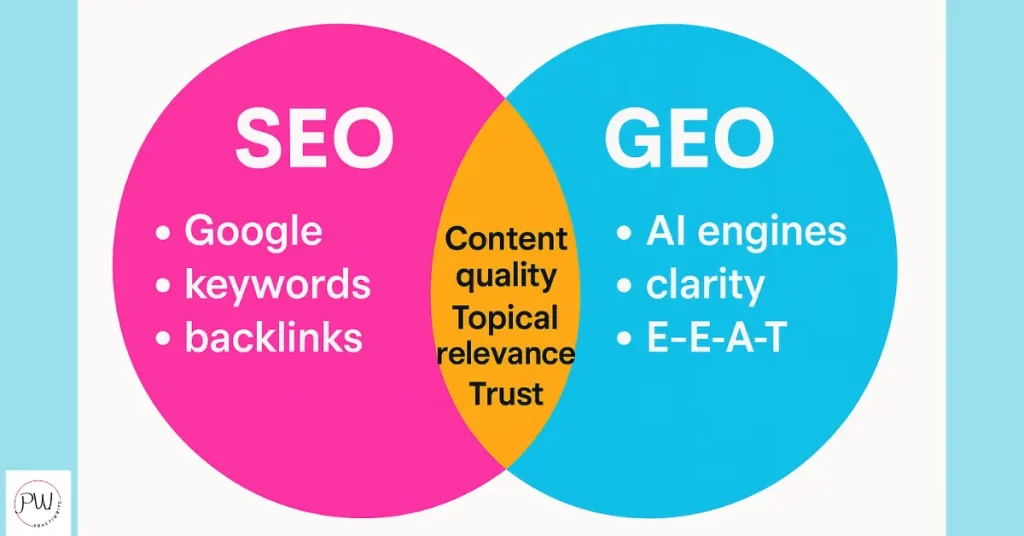
GEO For Dentists (Step-by-Step Strategy You Can Actually Use)
By now, you get the why behind GEO. Let’s move into the how because understanding the concept won’t put new patients in your chair.
This is the blueprint you need to optimize your website, content, and presence for Generative Engines like ChatGPT, Perplexity, Gemini, and Google’s SGE.
Step 1: Structure Your Website for AI Discovery
AI models don’t “browse” like humans. They extract information from your content based on clarity, structure, and signals of authority.
Here’s how to format your website pages for GEO:
- Use clear H1s and H2s that align with patient intent
(e.g. “Dental Implants in Denver” vs. “Smile Restoration Services”) - Break content into scannable sections with bulleted lists, Q&A blocks, and short paragraphs
- Add location-specific language on all core service pages
(e.g. “We provide root canal therapy for patients in West Knoxville and surrounding neighborhoods”) - Use FAQ sections that mirror how patients ask questions in AI tools
Use a tool like Surfer SEO or ClearScope to align your content with semantic relevance and topical authority; both of which help AI understand and cite your content.
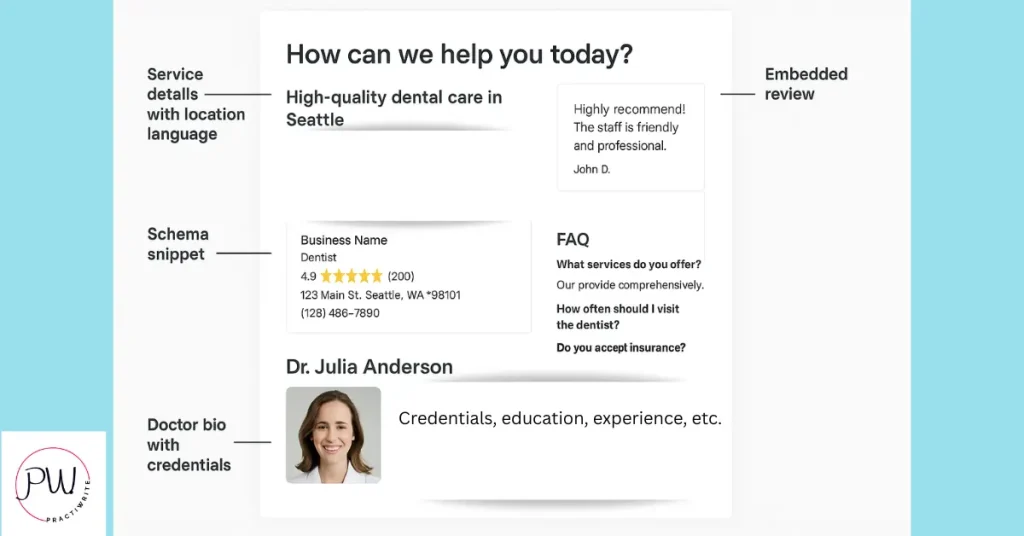
Step 2: Create GEO-Friendly Content That Answers Real Questions
The LLMs that power ChatGPT and Perplexity are trained to serve users direct, useful answers. That means your content must:
- Address real patient concerns directly (cost, pain, timing, results)
- Use conversational, human language—write like you speak
- Avoid marketing fluff and filler
- Include clear facts and numbers (pricing ranges, recovery times, etc.)
- Build trust through first-hand experience
Example Before & After:
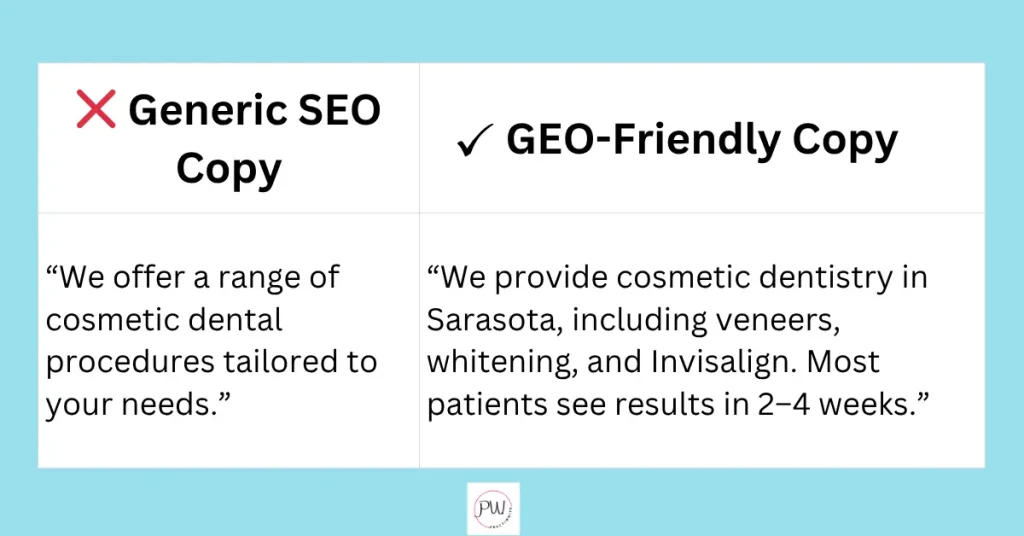
Step 3: Build and Showcase E-E-A-T (Experience, Expertise, Authority, Trust)
E-E-A-T is no longer optional. It’s the filter LLMs use to determine credibility.
How to show it:
- Add real photos of your team and office (not stock images)
- Include your credentials, education, and years in practice on your About page
- Add first-person insight in blog content: “At our practice, we’ve seen over 300 patients complete Invisalign in the last five years…”
- Publish case studies or patient stories (with permission and HIPAA compliant)
- Embed patient reviews directly on relevant service pages
According to Moz’s 2025 Local SEO Report, pages that demonstrate E-E-A-T clearly are 3x more likely to be cited by generative engines.
Step 4: Be Transparent About Pricing and Process
AI tools love content that removes friction for searchers. Dentists who openly share:
- Average treatment costs
- Expected timelines
- Insurance accepted
- Booking processes
…are more likely to be cited and recommended.
You don’t need to post a full rate sheet, but give realistic price ranges and set clear expectations. Patients appreciate it. So do AI assistants.
Step 5: Add Schema Markup and Location Signals
Behind-the-scenes data matters, too.
Use structured data (schema) to help LLMs and AI-enhanced search engines extract critical details. At a minimum, you should:
- Add LocalBusiness schema to your website (including NAP: Name, Address, Phone)
- Use Service schema for treatment pages
- Mark up FAQs, Reviews, and Team Member bios with proper schema
Tools like Mermaid or Schema.org Generator can help you generate clean, Google-compliant code.
Run your site through Google’s Rich Results Test to check if your schema is firing correctly.
Step 6: Update Frequently (AI Likes Fresh Content)
Stale websites don’t get cited.
Make sure you:
- Update core service pages at least every 6 months
- Refresh your homepage and About page with any new credentials, photos, or services
- Publish monthly blog content answering patient questions in Q&A format
According to Ahrefs, content that’s updated regularly and signals freshness is 58% more likely to appear in generative engine results.
Step 7: Monitor Your Visibility in AI Engines
New tools now allow you to track your presence in AI answers.
Try:
- AlsoAsked: See how real people phrase queries that LLMs will likely replicate
- Perplexity Pages: Search your business name or services and see what comes up
- Surfer SEO’s AI Visibility Tracking: Monitors inclusion in SGE and AI-generated search snippets
You can also test AI prompts manually, just like your patients do. Try typing into ChatGPT or Perplexity:
“Who is the top-rated dentist in [your city] for Invisalign?”
“What’s the average cost of veneers near me?”
If your name doesn’t show up, you’ve got work to do.
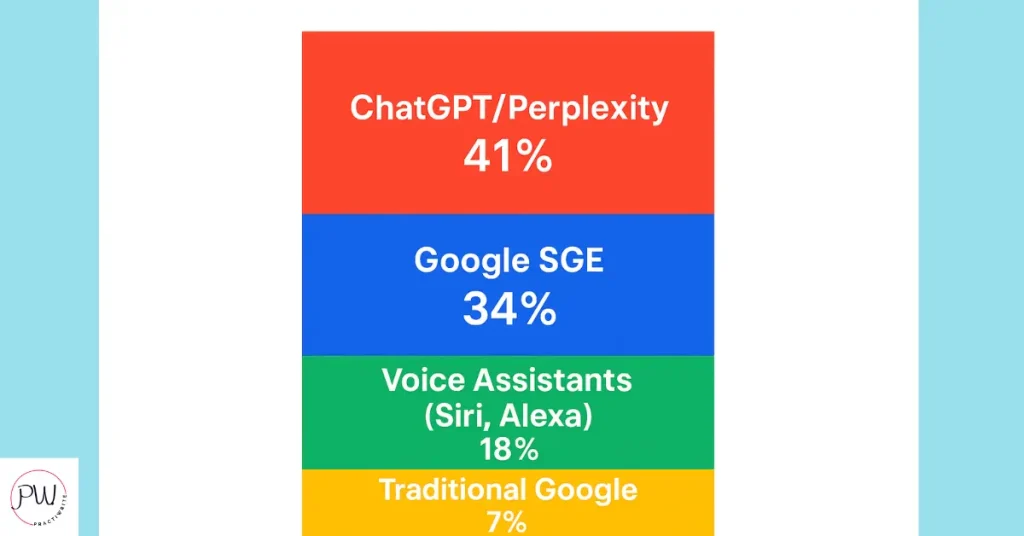
Real-World Results: Before & After GEO Implementation
Let’s talk about Dr. Mason (name and city changed for anonymity) a general dentist running a solo practice in Spokane, WA.
He had a clean website, good patient outcomes, and a small team of loyal staff.
But business had hit a ceiling. He was getting a few new patients here and there, mostly from referrals or insurance lists, but nowhere near his growth goals.
He knew something was off. So he reached out for help.
Before GEO: Invisible in the Engines That Matter Now
Here’s what his digital footprint looked like:
- Website was optimized for traditional SEO, but not AI search
- No clear location signals or conversational answers on service pages
- FAQs were outdated and buried on a separate page
- No patient quotes, real photos, or experience-based content
- Schema markup missing from major pages
- Zero presence in Perplexity, ChatGPT, or Google SGE results
When we prompted ChatGPT with:
“Who are the top-rated dentists in Spokane who offer dental implants?”
Dr. Mason wasn’t even mentioned.
The Fix: A GEO Makeover
Here’s what changed over a 90-day GEO implementation:
- Rewrote all service pages using conversational language and Q&A blocks
- Added location-based phrasing across content: Spokane, South Hill, Valley neighborhoods
- Created mini case studies and embedded real patient reviews on key pages
- Structured content with clean H2s, bulleted answers, and pricing guidance
- Implemented LocalBusiness, Service, and FAQ schema sitewide
- Updated About page with photos, credentials, and personal bio from Dr. Mason
- Published two GEO-optimized blog posts per month answering patient-style queries
- Tested prompts weekly across Perplexity and ChatGPT to monitor visibility
After GEO: Visibility → Clicks → Appointments
By the end of 90 days:
- Dr. Mason’s website appeared in 3 out of 5 tested Perplexity responses for implant-related local prompts
- ChatGPT recommended his practice by name in 2 local dental scenarios
- Google SGE cited one of his FAQ snippets on “Cost of dental implants in Spokane”
- Organic traffic grew by 38%, with a 21% increase in time on page
- Most importantly: new patient bookings jumped 27%, with 61% citing “online search” or “found you through an AI tool” in intake forms
Here’s the Lesson:
AI isn’t just changing how people search. It’s changing who they find.
Dr. Mason didn’t throw more money at Google Ads. He didn’t rebrand. He didn’t add a TikTok account.
We simply rewrote his website for the way people, and AI, actually search today.
That’s GEO.
Tools That Make GEO Easy for Dentists
You don’t need to be a tech wizard to start showing up in generative engines. These trusted tools can help you audit, optimize, and future-proof your content for AI visibility without guesswork.
Here’s what to keep in your digital toolkit:
Content Optimization & Topic Clarity
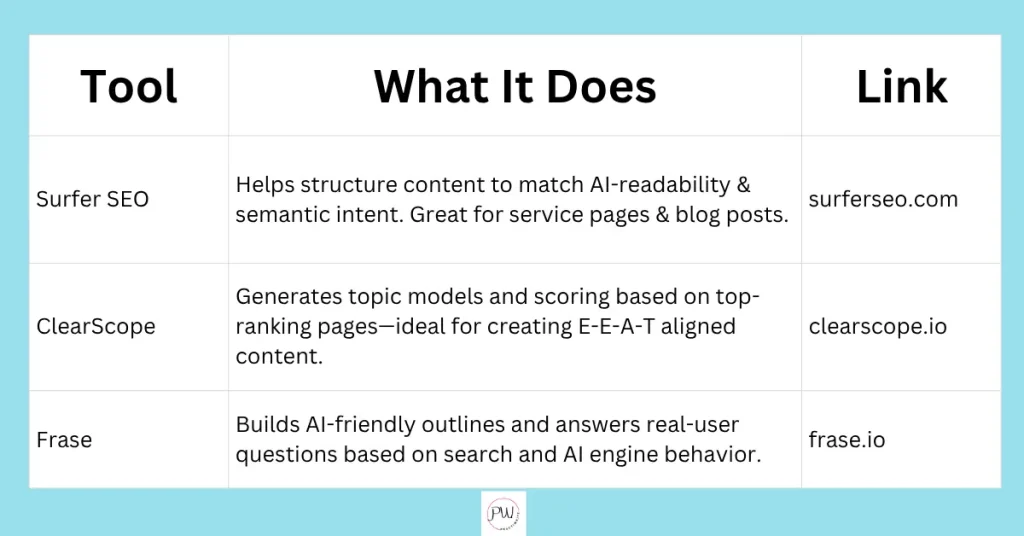
Schema Markup & Structured Data
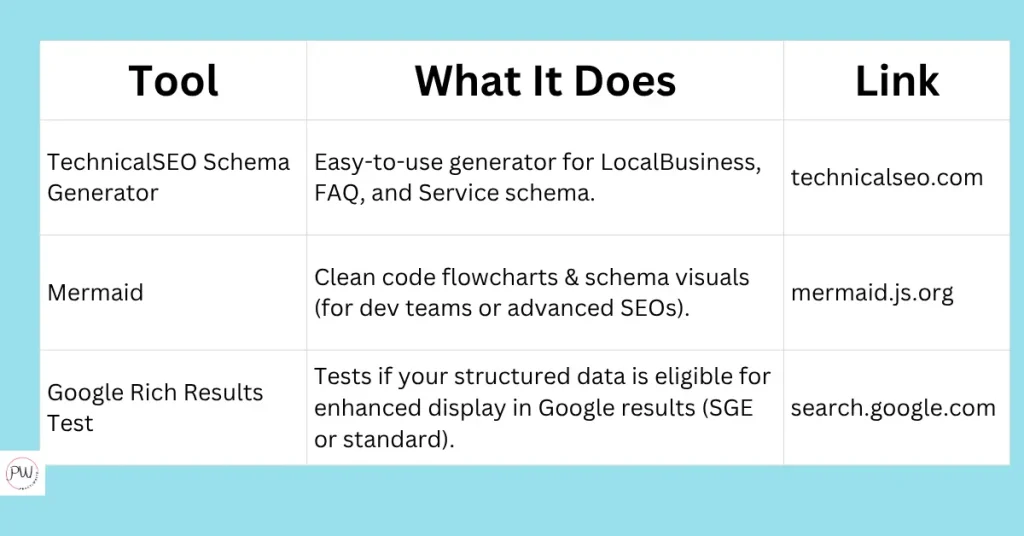
AI Search Monitoring & Prompt Testing
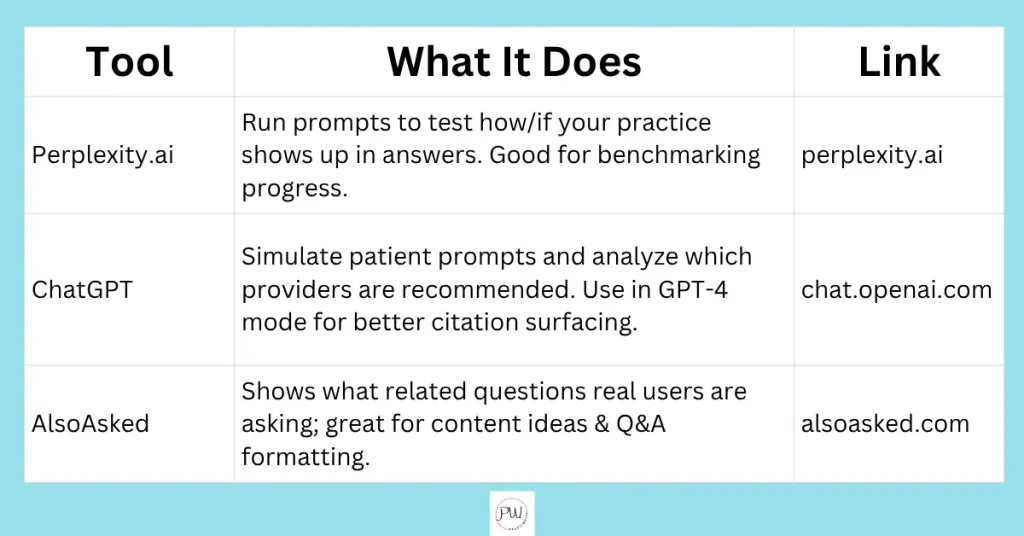
Trust Signals & Review Display
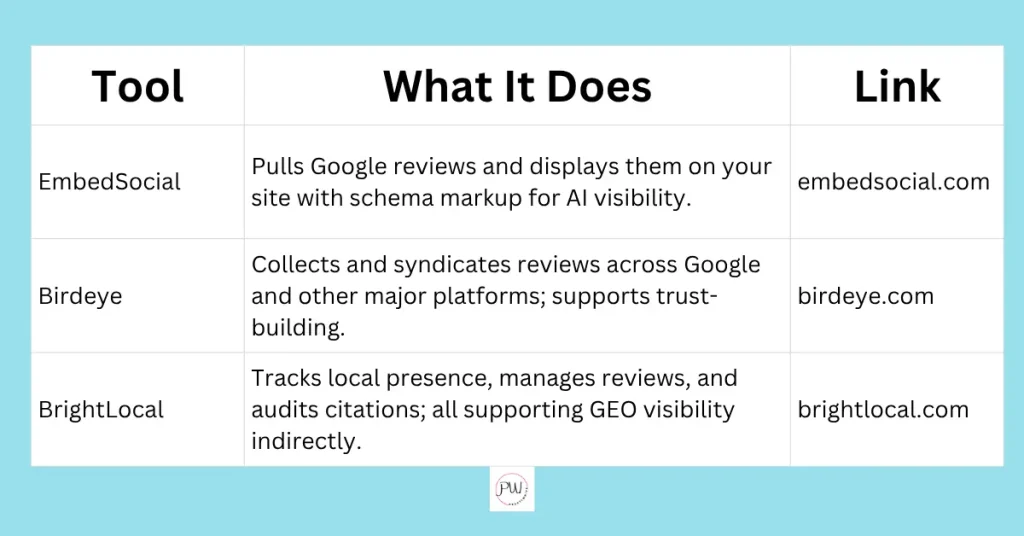
Don’t Let the Tools Overwhelm You
You don’t need all of these. Start with 2–3:
- One to help you structure your content (Surfer or Frase)
- One to help you test visibility in AI tools (ChatGPT or Perplexity)
- One to handle schema (TechnicalSEO Generator)
The key isn’t having the tools. It’s using them with intent and consistency.
Wrapping Up: Let’s Build Your Practice’s SEO & GEO Roadmap
You’ve made it this far because you know one thing: the way patients find dentists has changed and your practice needs to show up where it counts.
Generative Engine Optimization (GEO) isn’t a trend.
It’s the new foundation for digital visibility.
It’s how you get your practice:
- Recommended by AI tools like ChatGPT and Perplexity
- Mentioned in Google’s SGE answers instead of buried beneath them
- Chosen by high-intent patients who are actively looking for a provider like you
And the best part?
You don’t need to burn down your website or start from scratch. You need a clear, structured plan to evolve your current digital presence into one that works with AI, not against it.
That’s What the Dental Practice Roadmap Is For
This isn’t a sales call. This is a free, no-obligation strategy session built to show you:
- What content, pages, and trust signals you’re missing
- How SEO will impact your practice
- A custom roadmap tailored to your services, city, and goals
If you’re tired of being invisible online, or if you’re spending money on SEO that doesn’t move the needle. This is where you shift gears.
Ready to Get Picked Instead of Passed Over?
Book your free strategy session now and get your personalized Dental Practice Roadmap complete with real-time insights on how SEO and GEO can bring more patients through your door in Q4 2025 (and beyond).
Let’s build something future-proof.
10+ year content strategist, writer, author, and SEO consultant. I work exclusively with dental practices that want to grow and dominate their local areas.
10+ year content strategist, writer, author, and SEO consultant. I work exclusively with dental practices that want to grow and dominate their local areas.
